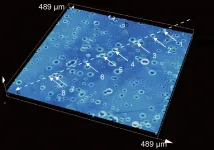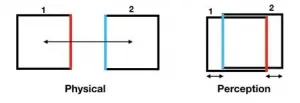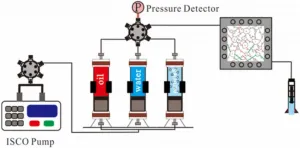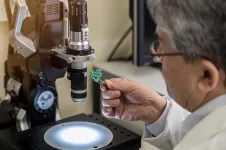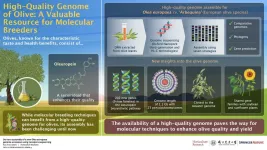(Press-News.org) Stimulation of the nervous system with neurotechnology has opened up new avenues for treating human disorders, such as prosthetic arms and legs that restore the sense of touch in amputees, prosthetic fingertips that provide detailed sensory feedback with varying touch resolution, and intraneural stimulation to help the blind by giving sensations of sight.
Scientists in a European collaboration have shown that optic nerve stimulation is a promising neurotechnology to help the blind, with the constraint that current technology has the capacity of providing only simple visual signals.
Nevertheless, the scientists' vision (no pun intended) is to design these simple visual signals to be meaningful in assisting the blind with daily living. Optic nerve stimulation also avoids invasive procedures like directly stimulating the brain's visual cortex. But how does one go about optimizing stimulation of the optic nerve to produce consistent and meaningful visual sensations?
Now, the results of a collaboration between EPFL, Scuola Superiore Sant'Anna and Scuola Internazionale Superiore di Studi Avanzati, published today in Patterns, show that a new stimulation protocol of the optic nerve is a promising way for developing personalized visual signals to help the blind - that also take into account signals from the visual cortex. The protocol has been tested for the moment on artificial neural networks known to simulate the entire visual system, called convolutional neural networks (CNN) usually used in computer vision for detecting and classifying objects. The scientists also performed psychophysical tests on ten healthy subjects that imitate what one would see from optic nerve stimulation, showing that successful object identification is compatible with results obtained from the CNN.
"We are not just trying to stimulate the optic nerve to elicit a visual perception," explains Simone Romeni, EPFL scientist and first author of the study. "We are developing a way to optimize stimulation protocols that takes into account how the entire visual system responds to optic nerve stimulation."
"The research shows that you can optimize optic nerve stimulation using machine learning approaches. It shows more generally the full potential of machine learning to optimize stimulation protocols for neuroprosthetic devices," continues Silvestro Micera, EPFL Bertarelli Foundation Chair in Translational Neural Engineering and Professor of Bioelectronics at the Scuola Superiore Sant'Anna.
Restoring sight, but with limited resolution
The idea is to stimulate the optic nerve to induce phosphenes, the sensation of light in a region of one's field of view. The EPFL scientists plan to use intraneural electrodes, ones that pierce through the nerve instead of being wrapped around it, but there are still tremendous constraints on the resulting perceived image.
The constraint comes from the physiology of the optic nerve compared to the dimensions of electrode technology. The intraneural electrode consists of stimulation sites, and these are few in number compared to the million axons bundled up in the optic nerve, the latter being no more than a few millimeters in diameter. In other words, a given stimulation site reaches hundreds to thousands of surrounding nerve fibers or axons coming from the retina, leading to very coarse electrical stimulation.
Tuning this coarse electrical stimulation is a major challenge for all neuroprosthetics in general, but even more so for optical signals which are extremely complex compared to signals providing sensory feedback from upper and lower limbs, for instance.
The scientists work is the first to feature automatic optimization of optic nerve stimulation protocols. "The most relevant conceptual advancement is linked to the fact that for the first time, we have defined the problem of optimizing nerve stimulation by 'closing the loop' on cortical activation patterns," explains Romeni. "In our model, the idea that we could exploit cortical signals to guide nerve stimulation produced results comparable to and better than the theoretical optimum for current approaches to nerve stimulation optimization."
"Our study shows that it is possible to elicit desired activity patterns in deep layers of a CNN that simulate cortical visual areas. The next step is to understand what patterns should be evoked in order to induce percepts of arbitrary visual objects," continues Davide Zoccolan, Professor of Neurophysiology and Head of SISSA Visual Neuroscience Lab. "To meet this challenge, we are now working on building predictive models of neuronal responses based on CNNs. These models will learn the "tuning" of visual cortical neurons based on their responses to a battery of visual images, thus uncovering the mapping between image space and response space that is central for sight restoration".
Clinical trials and the future ciphers
For the moment, the EPFL intraneural electrodes have not yet been tested in people.
With clinical trials planned within the next year in a collaboration with Italian partners at Policlinico Gemelli in Rome, the same place where implants for hand amputees were performed, the scientists wonder what the future volunteers will actually see.
"The translation to patients will require dealing with intersubject variability, a well-known problem in neuroprosthetics," says Romeni. "We are far from understanding everything about the nervous system and we know that the current technology has intrinsic limitations. Our method will help to tackle both and to deal with how the brain interprets stimulation, hopefully leading to more natural and effective protocols."
The challenges are tremendous, but the scientists are taking the steps to turn the vision into reality.
INFORMATION:
The study was funded by the Bertarelli Foundation.
Although plexiglass barriers are seemingly everywhere these days -- between grocery store lanes, around restaurant tables and towering above office cubicles -- they are an imperfect solution to blocking virus transmission.
Instead of capturing virus-laden respiratory droplets and aerosols, plexiglass dividers merely deflect droplets, causing them to bounce away but remain in the air. To enhance the function of these protective barriers, Northwestern University researchers have developed a new transparent material that can capture droplets and aerosols, effectively ...
New York, NY (June 16, 2021) -- Immune cells that normally repair tissues in the body can be fooled by tumors when cancer starts forming in the lungs and instead help the tumor become invasive, according to a surprising discovery reported by Mount Sinai scientists in Nature in June.
The researchers found that early-stage lung cancer tumors coopt the immune cells, known as tissue-resident macrophages, to help invade lung tissue. They also mapped out the process, or program, of how the macrophages allows a tumor to hurt the tissues the macrophage normally repairs. This process allows the tumor to hide from the immune system and proliferate into later, deadly stages of cancer.
Macrophages play a key ...
June 16, 2021, CLEVELAND: New findings from Cleveland Clinic researchers show for the first time that the gut microbiome impacts stroke severity and functional impairment following stroke. The results, published in Cell Host & Microbe, lay the groundwork for potential new interventions to help treat or prevent stroke.
The research was led by Weifei Zhu, Ph.D., and Stanley Hazen, M.D., Ph.D., of Cleveland Clinic's Lerner Research Institute. The study builds on more than a decade of research spearheaded by Dr. Hazen and his team related to the gut microbiome's role in cardiovascular health and disease, including the adverse effects of TMAO (trimethylamine N-oxide) - a byproduct produced when gut bacteria digest certain nutrients abundant in red meat and other animal ...
Our eyes move three times per second. Every time we move our eyes, the world in front of us flies across the retina at the back of our eyes, dramatically shifting the image the eyes send to the brain; yet, as far as we can tell, nothing appears to move. A new study provides new insight into this process known as "visual stabilization". The results are published in the Proceedings of the National Academy of Sciences.
"Our results show that a framing strategy is at work behind the scenes all the time, which helps stabilize our visual experience," says senior author Patrick Cavanagh, a research professor in psychological and brain sciences at Dartmouth ...
A joint paper went out in Journal of Petroleum Science and Engineering.
Petroleum, being a liquid compound, has very good migratory properties, and recovery methods take account of that - using various methods, oilers displace petroleum through cavities and vugs and extract it. However, sometimes oil is "locked" in low-permeability reservoirs, and water displacement used in such cases poses a high risk of reservoir flooding and workplace emergencies.
Many teams work on blocking high-permeability areas in order to make extraction a more controlled and safe process. In particular, there have yet been no efficient agents for reservoirs with high temperatures (up to 140 C) and mineralization (up to 250 grams ...
Professor Hermann Ehrlich places a piece of sponge in an alkaline, copper-containing ammonia solution that simulates a copper bath from the manufacture of circuit boards for electronic components. About 12 hours later the sponge has turned blue - when dry it is stronger than before, but still very light. "At a pH value of 9 the fibers of the spongin open and the organic compounds of the protein change," explains Prof. Hermann Ehrlich. The copper contained in the ammonia solution reacts immediately with the organic components of the spongin, especially with the amino acid residues, and forms the mineral atacamite. "Like a string, nanometer-sized crystals grow along with the spongin fiber," explains the scientist. ...
Olives, well-known for their characteristic bitter taste, are in high demand owing to the popularity of the oil that's derived from them. The health benefits of olive oil are well known, ranging from antiviral, anti-cancer, to even anti-hypertensive effects. These benefits are attributed to "oleuropein," the most abundant olive secoiridoid found in olives.
An efficient method to enhance the quality of plant products is by using molecular methods to manipulate their genes and enhancing their yield. With olives, however, this is still a challenge, because of a lack of sufficient genome data.
So far, the genomes of two European olive varieties have been sequenced. But to fully decipher ...
Lack of data on contraception uptake prior to the pandemic means no clear picture of the impact Covid-19 had on contraception use
Study from Warwick Medical School highlights need to maintain access to contraception during disasters
Researchers recommend making more contraception prescription-free and discuss the benefits and pitfalls of telehealth
Limited data on the uptake of contraception prior to and during crises such as the Covid-19 pandemic could mean unforeseen issues for sexual and reproductive health services, research from the University of Warwick concludes.
It identifies additional barriers that women faced in accessing contraception during the Covid-19 lockdown, including disruption to sexual health services and fears about contracting the virus, as ...
New research shows the UK's COVID-19 management decisions were based on an outdated pandemic modelling structure and suggests a more resilient approach would have been more effective.
In the initial months of the pandemic, regular updates using graphs showing how the R number was behaving was the mainstay of the Government's strategy for tackling COVID-19.
This type of infection transmission is usually mathematically-based on dividing the population into 'compartments'. Such an approach has been criticised for its limited scope and inability to capture critical factors, such as the ...
Results show BAT's Modern Oral nicotine pouches have a comparable toxicant profile to NRTs, which are currently considered the least risky of all nicotine products*†
The Modern Oral products have far fewer and significantly lower levels of toxicants‡ than cigarette smoke
Data demonstrates how BAT is building A Better Tomorrow™ by providing evidence to show how we are reducing the health impact of our business and delivering Tobacco Harm Reduction
London, 16 June: New research published today indicates that BAT's modern oral (MO) products in the form of tobacco-free nicotine pouches have a toxicant profile that is comparable to nicotine replacement therapies (NRTs) and much lower than traditional oral ...
